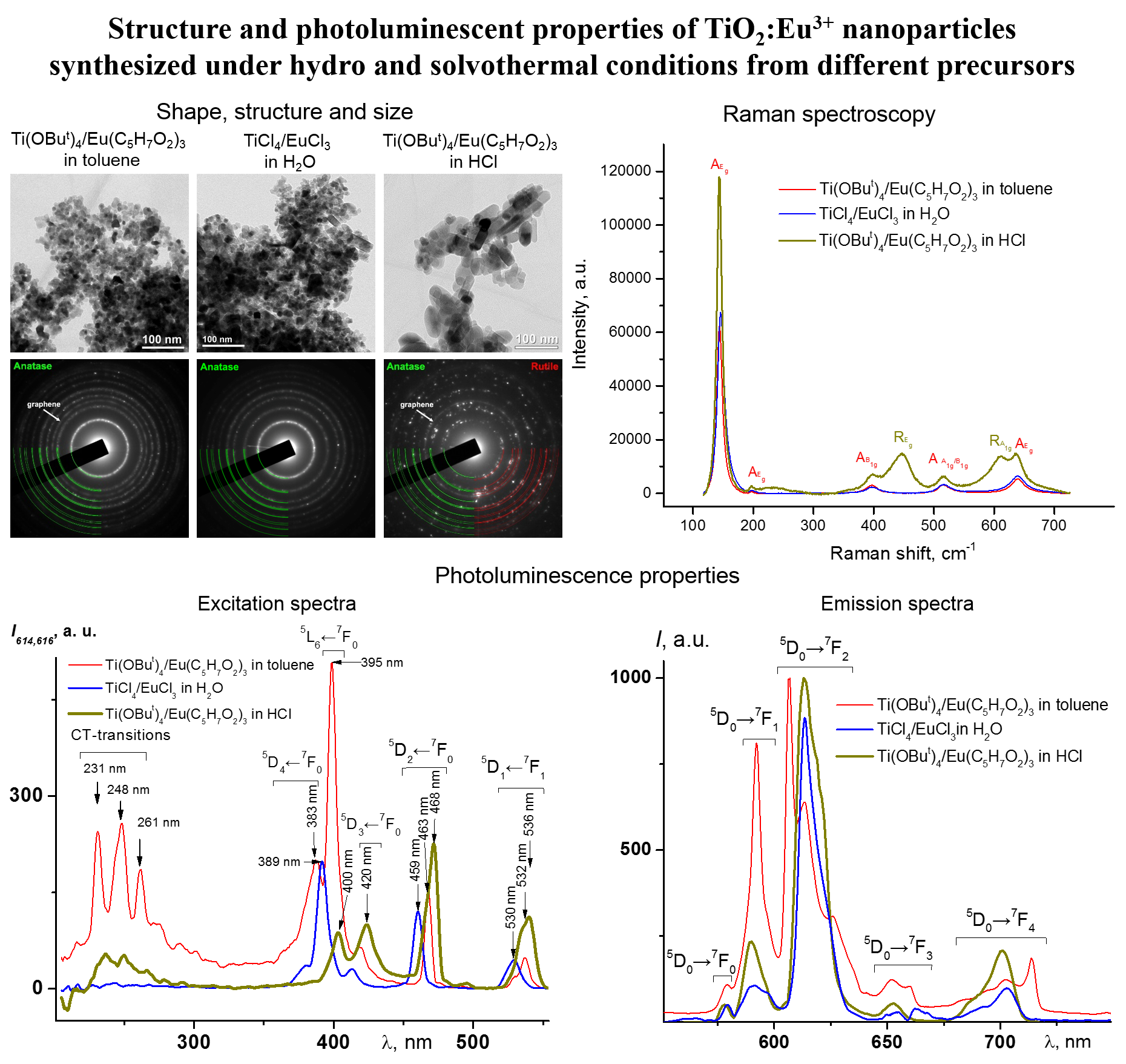NANOSYSTEMS: PHYSICS, CHEMISTRY, MATHEMATICS, 2019, 10 (3), P. 361–373
Structure and photoluminescent properties of TiO2:Eu3+ nanoparticles synthesized under hydro and solvothermal conditions from different precursors
A.Yu. Zavialova – Saint Petersburg Electrotechnical University “LETI”, ul. Professora Popova 5, 197376 Saint Petersburg; Saint-Petersburg State Institute of Technology (Technical University), Moskovsky prospect 26, Saint Petersburg, 190013, Russia; zavialova.a.y@gmail.com
A. N. Bugrov – Saint Petersburg Electrotechnical University “LETI”, ul. Professora Popova 5, 197376 Saint Petersburg; Institute of macromolecular compounds RAS, Bolshoy pr. 31, 199004 Saint Petersburg, Russia; alexander.n.bugrov@gmail.com
R.Yu. Smyslov – Institute of macromolecular compounds RAS, Bolshoy pr. 31, 199004 Saint Petersburg; Peter the Great Saint Petersburg Polytechnic University, Polytechnicheskaya 29, 195251 Saint Petersburg, Russia; urs1968@gmail.com
D. A. Kirilenko – Ioffe Institute RAS, Politekhnicheskaya ul. 26, 194021 Saint Petersburg; ITMO University, 197101, Kronverskii avenue 49, Saint Petersburg, Russia; demid.kirilenko@mail.ioffe.ru
T.V. Khamova – Grebenshchikov Institute of Silicate Chemistry RAS, Makarova nab. 2., letter B, 199034 Saint Petersburg, Russia; tamarakhamova@gmail.com
G. P. Kopitsa – Grebenshchikov Institute of Silicate Chemistry RAS, Makarova nab. 2., letter B, 199034 Saint Petersburg; Petersburg Nuclear Physics Institute, NRC KI, Orlova roscha mcr. 1, 188300, Gatchina, Leningrad region, Russia; kopitsa_gp@pnpi.nrcki.ru
C. Licitra – University Grenoble Alpes, CEA, LETI, F-38000 Grenoble, France; christophe.licitra@cea.fr
D. Rouchon – University Grenoble Alpes, CEA, LETI, F-38000 Grenoble, France; denis.rouchon@cea.fr
Crystalline phosphors of Eu3+-doped titania (TiO2:Eu3+) were prepared by hydro and solvothermal synthesis with luminescent ion concentration of 2 mol.%. The structure and shape of the synthesized nanoparticles were characterized using X-ray powder diffraction, transmission electron microscopy, and Raman spectroscopy. Changes in the emission, excitation spectra, and the intensity decay of the photoluminescence for TiO2:Eu3+ nanoparticles were analyzed their phase composition. The photoluminescence of synthesized TiO2:Eu3+ crystalline phosphors depends on whether the said nanophosphors are formed from organometallic or inorganic precursors under hydro- and solvothermal conditions. Indeed, photoluminescence excitation at wavelengths ranging from 350–550 nm leads to splitting of electron dipole transitions into Stark components according to the symmetry of the Eu3+ surroundings. Also, both nanoparticles with the anatase structure and phosphors predominantly containing rutile showed very short photoluminescence lifetimes.
Keywords: hydrothermal synthesis, titania, europium, solid solution, anatase, rutile, nanophosphors, photoluminescence, fluorescence lifetime.
PACS 78.67. n; 78.67.Bf DOI
10.17586/2220-8054-2019-10-3-361-373
